Assessment of the toxicity and carcinogenicity of double-walled carbon nanotubes in the rat lung after intratracheal instillation: a two-year study
- PMID: 35449069
- PMCID: PMC9026941
- DOI: 10.1186/s12989-022-00469-8
Assessment of the toxicity and carcinogenicity of double-walled carbon nanotubes in the rat lung after intratracheal instillation: a two-year study
Abstract
Background: Considering the expanding industrial applications of carbon nanotubes (CNTs), safety assessment of these materials is far less than needed. Very few long-term in vivo studies have been carried out. This is the first 2-year in vivo study to assess the effects of double walled carbon nanotubes (DWCNTs) in the lung and pleura of rats after pulmonary exposure.
Methods: Rats were divided into six groups: untreated, Vehicle, 3 DWCNT groups (0.12 mg/rat, 0.25 mg/rat and 0.5 mg/rat), and MWCNT-7 (0.5 mg/rat). The test materials were administrated by intratracheal-intrapulmonary spraying (TIPS) every other day for 15 days. Rats were observed without further treatment until sacrifice.
Results: DWCNT were biopersistent in the rat lung and induced marked pulmonary inflammation with a significant increase in macrophage count and levels of the chemotactic cytokines CCL2 and CCL3. In addition, the 0.5 mg DWCNT treated rats had significantly higher pulmonary collagen deposition compared to the vehicle controls. The development of carcinomas in the lungs of rats treated with 0.5 mg DWCNT (4/24) was not quite statistically higher (p = 0.0502) than the vehicle control group (0/25), however, the overall incidence of lung tumor development, bronchiolo-alveolar adenoma and bronchiolo-alveolar carcinoma combined, in the lungs of rats treated with 0.5 mg DWCNT (7/24) was statistically higher (p < 0.05) than the vehicle control group (1/25). Notably, two of the rats treated with DWCNT, one in the 0.25 mg group and one in the 0.5 mg group, developed pleural mesotheliomas. However, both of these lesions developed in the visceral pleura, and unlike the rats administered MWCNT-7, rats administered DWCNT did not have elevated levels of HMGB1 in their pleural lavage fluids. This indicates that the mechanism by which the mesotheliomas that developed in the DWCNT treated rats is not relevant to humans.
Conclusions: Our results demonstrate that the DWCNT fibers we tested are biopersistent in the rat lung and induce chronic inflammation. Rats treated with 0.5 mg DWCNT developed pleural fibrosis and lung tumors. These findings demonstrate that the possibility that at least some types of DWCNTs are fibrogenic and tumorigenic cannot be ignored.
Keywords: Carcinogenicity; Double walled carbon nanotubes; Rats; Toxicity; Two-year study.
© 2022. The Author(s).
Conflict of interest statement
The authors declare that they have no competing interests.
Figures










Similar articles
-
Comparative pulmonary toxicity of a DWCNT and MWCNT-7 in rats.Arch Toxicol. 2019 Jan;93(1):49-59. doi: 10.1007/s00204-018-2336-3. Epub 2018 Oct 19. Arch Toxicol. 2019. PMID: 30341734 Free PMC article.
-
Comparative carcinogenicity study of a thick, straight-type and a thin, tangled-type multi-walled carbon nanotube administered by intra-tracheal instillation in the rat.Part Fibre Toxicol. 2020 Oct 15;17(1):48. doi: 10.1186/s12989-020-00382-y. Part Fibre Toxicol. 2020. PMID: 33054855 Free PMC article.
-
Carcinogenic effect of potassium octatitanate (POT) fibers in the lung and pleura of male Fischer 344 rats after intrapulmonary administration.Part Fibre Toxicol. 2019 Sep 2;16(1):34. doi: 10.1186/s12989-019-0316-2. Part Fibre Toxicol. 2019. PMID: 31477126 Free PMC article.
-
Review of toxicity studies of carbon nanotubes.J Occup Health. 2017 Sep 28;59(5):394-407. doi: 10.1539/joh.17-0089-RA. Epub 2017 Aug 8. J Occup Health. 2017. PMID: 28794394 Free PMC article. Review.
-
Pulmonary toxicity of carbon nanotubes and asbestos - similarities and differences.Adv Drug Deliv Rev. 2013 Dec;65(15):2078-86. doi: 10.1016/j.addr.2013.07.014. Epub 2013 Jul 27. Adv Drug Deliv Rev. 2013. PMID: 23899865 Review.
Cited by
-
Safety of Mechanically Fibrillated Cellulose Nanofibers (CNFs) by Inhalation Exposure Based on TG412.Nanomaterials (Basel). 2025 Jan 28;15(3):214. doi: 10.3390/nano15030214. Nanomaterials (Basel). 2025. PMID: 39940189 Free PMC article.
-
Fullerene and fullerene whisker are not carcinogenic to the lungs and pleura in rat long-term study after 2-week intra-tracheal intrapulmonary administration.Arch Toxicol. 2024 Dec;98(12):4143-4158. doi: 10.1007/s00204-024-03863-7. Epub 2024 Sep 13. Arch Toxicol. 2024. PMID: 39269499 Free PMC article.
-
Dynamic QSAR modeling for predicting in vivo genotoxicity and inflammation induced by nanoparticles and advanced materials: a time-dose-property/response approach.J Nanobiotechnology. 2025 Jun 6;23(1):420. doi: 10.1186/s12951-025-03510-y. J Nanobiotechnology. 2025. PMID: 40481558 Free PMC article.
-
Carbon Nanotubes as Carriers in Drug Delivery for Non-Small Cell Lung Cancer, Mechanistic Analysis of Their Carcinogenic Potential, Safety Profiling and Identification of Biomarkers.Int J Nanomedicine. 2022 Dec 8;17:6157-6180. doi: 10.2147/IJN.S384592. eCollection 2022. Int J Nanomedicine. 2022. PMID: 36523423 Free PMC article. Review.
-
A Review of the Carcinogenic Potential of Thick Rigid and Thin Flexible Multi-Walled Carbon Nanotubes in the Lung.Nanomaterials (Basel). 2025 Jan 22;15(3):168. doi: 10.3390/nano15030168. Nanomaterials (Basel). 2025. PMID: 39940144 Free PMC article. Review.
References
-
- Ibrahim K. Carbon nanotubes-properties and applications: a review. Carbon letters. 2013;14:131–144. doi: 10.5714/CL.2013.14.3.131. - DOI
Publication types
MeSH terms
Substances
LinkOut - more resources
Full Text Sources
Medical

